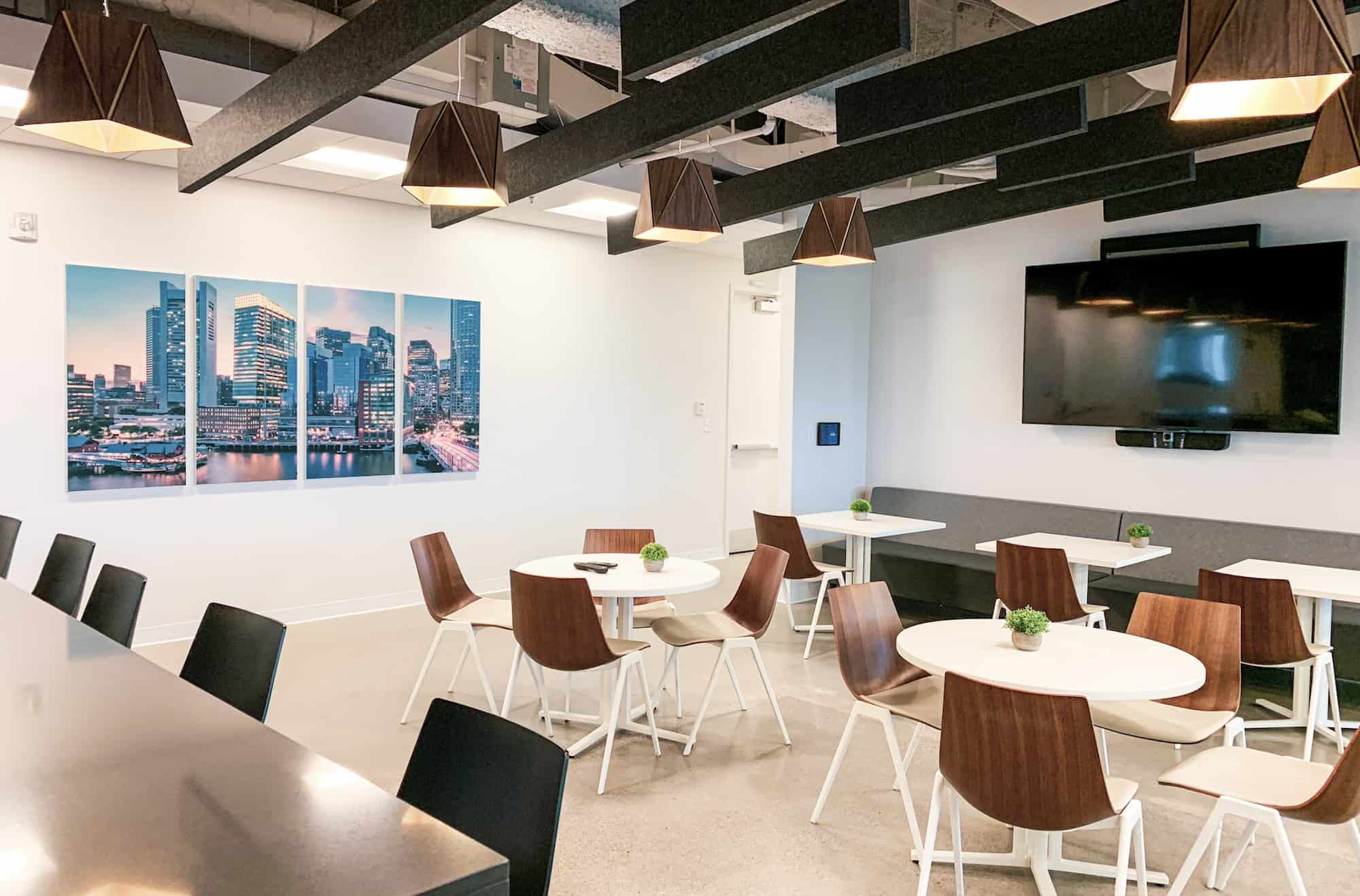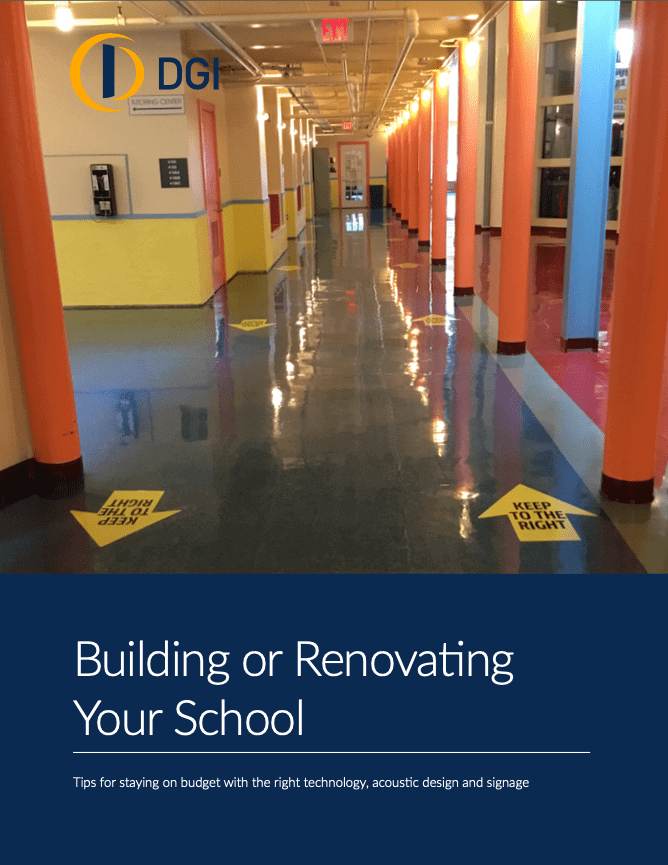Cafeterias at schools, colleges, hospitals and corporate offices are places where people come together to dine and gather. While their primary function is to provide a central location for efficiently serving food to a large group, cafeterias aren’t particularly well-known for their impressive looks. But that doesn’t mean all cafeterias need to be boring; instead, making simple design choices can help transform your organization’s cafeteria into a welcoming, aesthetically pleasing space.
Since some organizations are in need of more space, modern cafeterias have become adaptable multipurpose rooms with design needs of their own. To better understand the latest cafeteria design concepts, let’s explore why it’s essential to make the right design choices.
The Importance of Thoughtful Cafeteria Design Concepts
Considering the current state of the economy and today’s staffing challenges, companies must be innovative with their available dining resources. Modern cafeteria design is less utilitarian and more focused on providing sought-after gathering areas, overflow collaboration spaces for students (in educational environments), ad hoc meeting locations and opportunities to introduce a quick hit of brand identity with company logos and decals.
The layout of a common space or cafeteria must also address a vital issue: traffic flow. A well-designed cafeteria layout creates a functional, low-stress environment for all visitors as they navigate the space.
Once you have your layout, consider the following points, which directly impact a cafeteria’s functionality and service:
Color and Light
Disrupting the expected norm of fluorescent lighting and bland décor is a great way to add visual interest to your cafeteria design. Consider adding functional focal points (such as architectural acoustic management solutions, video walls or wall coverings) and lighting that mimics natural sunlight, especially in enclosed cafeteria spaces. Market research can determine the best colors to use throughout the space, and accent colors that complement your brand kit can tie the overall design into your organization’s aesthetic.
Kitchen Design
When designing a cafeteria, the first step is determining the project’s scope, whether for a new building or as part of a renovation. In addition to a cafeteria layout that’s optimized for foot traffic patterns, you should also think about the way your kitchen operates to ensure it has a well-organized space for food prep and that it promotes quick service.
Complying with local building codes in the design phase will also save costs during construction and afterward. The design process should include specs for kitchen equipment, utilities, storage and both restroom and cleaning facilities to ensure proper hygiene and food safety standards are met.
Modern Technology
There are countless ways to use interactive communication and technology to improve the atmosphere in your cafeteria. LED walls provide opportunities for infotainment, marketing, company news, workforce updates and art. You can even make use of video content streaming services to create a custom feed that’s targeted toward your cafeteria’s visitors.
Looking to transform your cafeteria into an entertainment hub? You can also integrate an AV system into its design to bring in music, display trivia or use your video wall to screen movies or presentations.
Sound Proofing
Anywhere groups of people congregate to dine and converse, the noise level can quickly rise to unpleasant levels. Ensure that your cafeteria design factors in soundproofing methods to reduce the loud buzz of conversation that typically fills cafeteria spaces. Acoustic solutions are available in various sizes, styles and shapes — many of which can be custom painted or printed.
Cafeteria Design Ideas for 2025
Improving your cafeteria’s design can significantly impact its appearance, appeal and functionality, all while increasing its popularity and usefulness. To achieve this, consider the following six tips:
- Make the most of your space with the right seating.
Furniture placement and style significantly shape a cafeteria’s ambiance. In larger spaces, encourage guests to linger longer by incorporating comfortable chairs with plush upholstery. Conversely, opting for sleeker styles in smaller areas can open up the room. - Create intimate seating sections.
Consider incorporating booths and cluster seating in a spacious cafeteria to create a relaxed and casual atmosphere for your guests to socialize. Another option is to divide the area into smaller sections using barrier walls and plants for a more intimate setting. - Embrace flexible seating options.
Whether your cafeteria is large or small, adaptable furniture enables you to easily customize the space depending on your needs. You can create different arrangements for various occasions — from formal banquets to casual meal times — and change the atmosphere for special events using simple tables and chairs that can be rearranged or stored away neatly. - Tailor the look and feel of your space.
Create an environment that appeals most to your regular visitors. Your approach will vary based on your workplace culture, environmental design, organizational marketing and the people you serve. For instance, a corporate cafeteria might prioritize a modern and luxurious ambiance while an artistic institution will likely focus more on original artwork and stylish interior design trends. - Utilize soothing music and AV options.
Consider using music, ambient sound and graphics to create a welcoming ambiance in your cafeteria. By selecting the right tunes, you can entice more people to come and enjoy a meal — but remember to make sure that the music you choose fits in with the type of environment you want to create. If you’re planning on opening your cafeteria up as a space to host meetings and gatherings, you can also customize the cafeteria’s sound system to accommodate larger groups. - Incorporate greenery.
Many people enjoy incorporating indoor houseplants into their homes and offices for a touch of nature, and this trend also applies to cafeteria interior design. Adding a few potted plants can be an inexpensive and effective way to liven up your space. Plants create a feeling of freshness and openness, which complements the current eco-friendly design trend well.
Quick Cafeteria Design Tips
If you’re looking for more ways to improve your cafeteria design, check out these helpful tips:
- Consider implementing a traffic management system for smaller spaces that receive a high volume of visitors.
- To save time and money, choose furniture that’s both durable and easy to care for.
- Place tray return stations in close proximity to your cafeteria’s seating area for guest convenience and to keep the area clean and organized.
- If you have the space, consider adding charging stations for visitors’ devices.
- Planning to use your cafeteria as an all-purpose room? Invest in the appropriate AV infrastructure and always work with a professional, such as DGI.
Creating a cafeteria that incorporates innovative, technological enhancements is a great way to make it appealing to visitors. And with the right design plan and partner, your cafeteria can be both beautiful and useful. If you’re interested in discussing your cafeteria design ideas, contact DGI Communications. Our team is ready to help you explore ways to create the perfect space.


